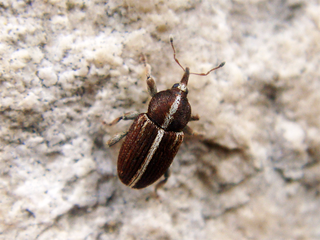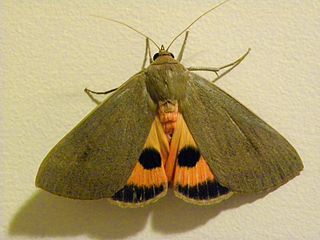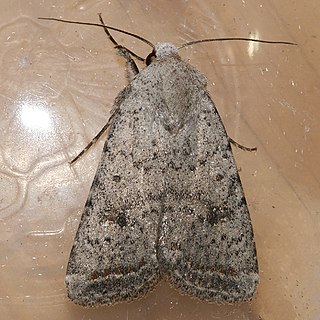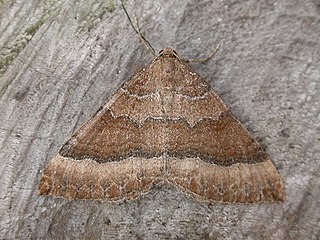
The soldier beetles (Cantharidae) are relatively soft-bodied, straight-sided beetles. They are cosmopolitan in distribution. One of the first described species has a color pattern reminiscent of the red coats of early British soldiers, hence the common name. They are also known commonly as leatherwings because of their soft elytra.

The beetle subfamily Curculioninae is part of the weevil family Curculionidae. It contains over 23,500 described species in 2,200 genera, and is therefore the largest weevil subfamily. Given that the beetle order (Coleoptera) contains about one-quarter of all known organisms, the Curculioninae represent one of the – if not the – most successful radiations of terrestrial Metazoa.

The Pyralini are a tribe of snout moths described by Pierre André Latreille in 1809. They belong to the subfamily Pyralinae, which contains the "typical" snout moths of the Old World and some other regions. The genus list presented here is provisional.

The Eudaminae are a subfamily of skipper butterflies. Their original type genus Eudamus is today a junior synonym of Urbanus. They are largely found in the Neotropics, with some extending into temperate North America, and one genus, Lobocla, endemic to East Asia.

The Caradrinini are a mid-sized tribe of moths in the family Noctuidae.

The Depressariinae – sometimes spelled "Depressiinae" in error – are a subfamily of moths in the superfamily Gelechioidea. Like their relatives therein, their exact relationships are not yet very well resolved. It has been considered part of family Elachistidae sensu lato or included in an expanded Oecophoridae. In modern classifications they are treated as the distinct gelechioid family Depressariidae.

Asthenini is a tribe of geometer moths under subfamily Larentiinae first described by Warren in 1893. The tribe has been combined with Eupitheciini in the past, most notably by Jeremy Daniel Holloway in his work The Moths of Borneo.

Chesiadini is a tribe of geometer moths under subfamily Larentiinae. The tribe was described by Stephens in 1850.

Hydriomenini is a tribe of geometer moths under subfamily Larentiinae. The tribe was erected by Edward Meyrick in 1872.

Melanthiini is a tribe of geometer moths under subfamily Larentiinae. The tribe was described by Philogène Auguste Joseph Duponchel in 1845.

Xanthorhoini is a tribe of geometer moths under subfamily Larentiinae. The tribe was described by Pierce in 1914.

Cataclysmiini is a tribe of geometer moths in subfamily Larentiinae.

Larentiini is a tribe of geometer moths under subfamily Larentiinae. The tribe was first described by Philogène Auguste Joseph Duponchel in 1845.

Operophterini is a tribe of geometer moths under subfamily Larentiinae.

Trichopterygini is a tribe of geometer moths under subfamily Larentiinae. The tribe was described by Warren in 1894.

Perizomini is a tribe of geometer moths under subfamily Larentiinae. It was first proposed by Claude Herbulot in 1961. It contains four genera, including the eponymous Perizoma.

Sterrhini is a tribe of the geometer moth family (Geometridae), with about 825 species in 19 genera. There are also 6 genera with 36 species tentatively associated with the tribe. The tribe was erected by Edward Meyrick in 1892.

Anomologinae is a subfamily of moths in the family Gelechiidae.
Apatetrinae is a subfamily of moths in the family Gelechiidae. The subfamily was described by Edward Meyrick in 1947.

Baptini is a tribe of geometer moths in the subfamily Ennominae.



















